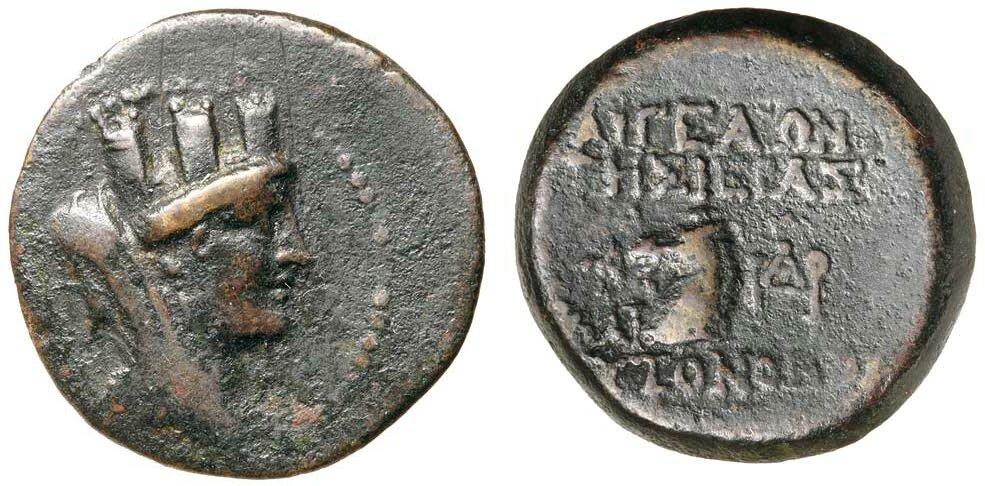H 262 - Aegeae, bronze, NC, 200-30 BC
From SILVER
200 BCE - 30 BCE Bronze
Description
| ObverseInscription or printing placed on the obverse.: | Veiled and turreted bust to right of Tyche city goddess, border of dots. |
| ReverseInscription or printing placed on the reverse.: | ΑΙΓΕΑΙΩΝ ou ΑΙΓΕΑΙΩΝ ΤΗΣ ΙΕΡΑΣ ΚΑΙ ΑΥΤΟΝΟΜΟΥ (Greek).Bridled horse's head to left, monogram HAP to right, above **AIGEAIWN/ THS IERAS/KAI /[A]UTONOMOU. |
Mint and issuing power
| MintIdentifies the place of manufacture or issue of a numismatic object.: | Aegeae | Ancient regionAncient region.: | Cilicia | Modern countryModern country: Turkey | AuthorityIdentifies the issuing power. The authority can be "pretended" when the name or the portrait of X is on the coin but he/she was not the issuing power. It can also be "uncertain" when there is no mention of X on the coin but he/she was the issuing power according to the historical sources: |
Chronology
| FromIdentifies the initial date in a range assigned in a numismatic context. | 200 BCE | toIdentifies the final date in a range assigned in a numismatic context.. | 30 BCE | PeriodTime period of the numismatic object.: Hellenistic 323-30 BC |
Physical description
| MetalThe physical material (usually metal) from which an object is made.: | Bronze |
Median weightMedian of the weights of numismatic objects (in grams). in grams | 6.00 | DenominationTerm indicating the value of a numismatic object. Examples: tetradrachm, chalkous, denarius.: | StandardStandard.: |
Image

H262 Aegeae bronze.jpeg [1]
References
| Die study referencePublication of the study: | Bloesch 19821Bloesch 1982, p. 53-96, pl. 17-22. | ||
| Coin series referenceReference to coin series study: | Sear II2Sear II, n° 5513-5515, RQEMH3RQEMH, n° 262 | ||
Obverse dies distribution
| FrequencyFrequency of specimen in distribution. ᵖ | Number of obversesNumber of obverse dies. ᵖ (o) | % (o) | Number of coinsNumber of coins. (n) | % (n) | Die nameName(s) of the die(s). |
| 1 | 26 | 52 | 26 | 22.41 | 21, 32, 37, 46, 50, 56, 113, 114, 118, 122, 133, 134, 150, 154, 155, 166, 204, 205, 206, 207, 208, 260, 261, 262, 263 |
| 2 | 7 | 14 | 14 | 12.07 | 26, 57, 131, 151, 162, 164, 167 |
| 3 | 5 | 10 | 15 | 12.93 | 47, 58, 115, 119, 159 |
| 4 | 8 | 16 | 32 | 27.59 | 28, 33, 51, 123, 127, 135, 153, 169 |
| 5 | 2 | 4 | 10 | 8.62 | 20, 107 |
| 8 | 1 | 2 | 8 | 6.9 | 38 |
| 11 | 1 | 2 | 11 | 9.48 | 139 |
| Total | 50 of 50 | 100 | 116 of 116 | 100 |
Reverse dies distribution
no distribution is available
Quantification
| Number of obversesNumber of obverse dies. ᵖ (o) | 50 | Number of singletons (o1)The number of singleton coins. ᵖ | 26 |
| Number of reverse diesNumber of reverse dies. (r) | 99 | Number of coinsNumber of coins. (n) | 116 |
| Coins per obverse dieNumber of coins per obverse die. (n/o) | 2.32 | Coins per reverse dieNumber of coins per reverse die. (n/r) | 1.17 |
| Reverse per obverse ratioRatio of obverse dies divided by reverse dies. (r/o) | 1.98 | Percentage of singletons (o1)number of coins (n) divided by the number of singletons (o1) ᵖ | 52 % |
| Original number of dies (O) (Carter 1983 formula)The estimation of the number of coins according to Carter 1983 ᵖ | 72.88 | Coins struck if 20,000 as average productivity per dieCoins made if the average productivity for obverses (according to Carter) is 20,000. ᵖ | 1,457,600 |
| Original number of dies (O) (Esty 2011 formula)The estimation of the number of coins according to the singleton formula in Esty 2011 ᵖ (O) | 87.88 | Survival rate if 20,000 as average productivity per dieSurvival rate if average productivity is 20,000. ᵖ | 0.00008 |
| Coverage (o = % of O) (Esty 1984 formula)Esty 1984 - coverage (% of O) ᵖ (o = % of O) | 77.59% | Die productivity if survival rate 1/2,000Average productivity if survival rate is 1/2,000. ᵖ | 3,183.32 |
| Weight of silver (in kg) if 20,000 coins per die (O = Carter formula)Carter 1983 * Median weight * 20000 (*10 if gold or electrum) ᵖ | n.a. | Die productivity if survival rate 1/5,000Average productivity if survival rate is 1/5,000. ᵖ | 7,958.29 |
Remarks